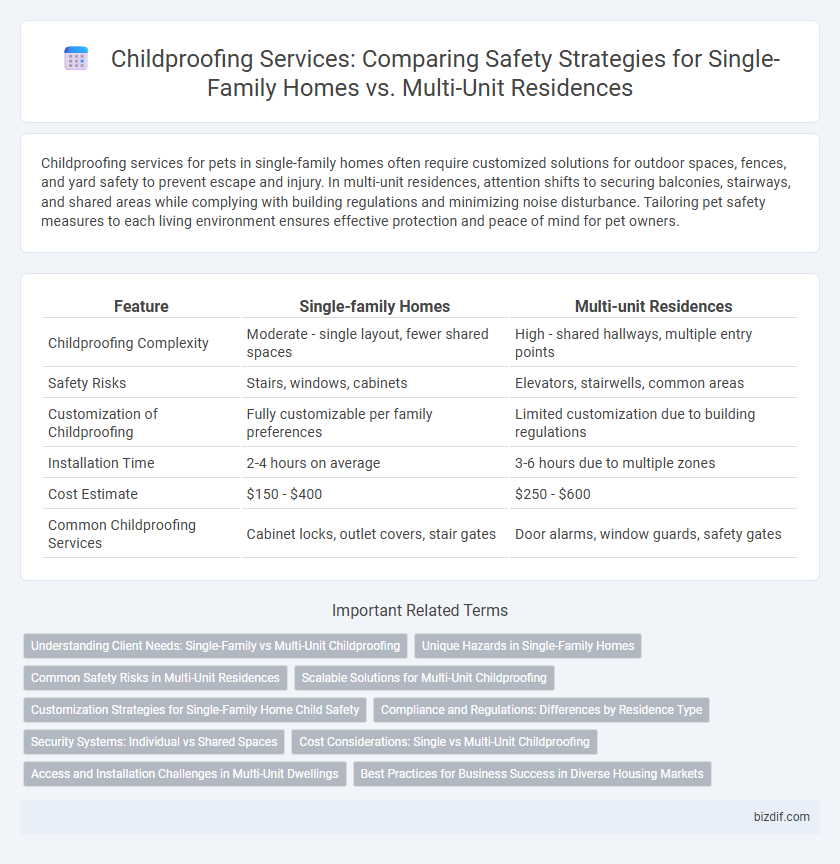Childproofing services for pets in single-family homes often require customized solutions for outdoor spaces, fences, and yard safety to prevent escape and injury. In multi-unit residences, attention shifts to securing balconies, stairways, and shared areas while complying with building regulations and minimizing noise disturbance. Tailoring pet safety measures to each living environment ensures effective protection and peace of mind for pet owners.
Table of Comparison
| Feature | Single-family Homes | Multi-unit Residences |
|---|---|---|
| Childproofing Complexity | Moderate - single layout, fewer shared spaces | High - shared hallways, multiple entry points |
| Safety Risks | Stairs, windows, cabinets | Elevators, stairwells, common areas |
| Customization of Childproofing | Fully customizable per family preferences | Limited customization due to building regulations |
| Installation Time | 2-4 hours on average | 3-6 hours due to multiple zones |
| Cost Estimate | $150 - $400 | $250 - $600 |
| Common Childproofing Services | Cabinet locks, outlet covers, stair gates | Door alarms, window guards, safety gates |
Understanding Client Needs: Single-Family vs Multi-Unit Childproofing
Single-family homes often require customized childproofing solutions targeting individual rooms and outdoor spaces, while multi-unit residences demand standardized safety features to comply with building regulations and accommodate shared areas. Clients in single-family homes prioritize tailored measures such as stair gates and cabinet locks, whereas multi-unit residents focus on communal safety elements like secure entry points and fire escape accessibility. Understanding these distinct needs enables childproofing services to deliver effective, context-specific safety strategies that protect children in varying living environments.
Unique Hazards in Single-Family Homes
Single-family homes often feature unique hazards such as unsecured stairways, basement access, and standalone garages that require specialized childproofing solutions. Unlike multi-unit residences, these homes may have multiple entry points and varied layouts that increase potential risks for children. Custom childproofing strategies address these challenges by securing doors, windows, and hazardous areas specific to the single-family home environment.
Common Safety Risks in Multi-Unit Residences
Multi-unit residences present distinct childproofing challenges compared to single-family homes due to shared spaces like stairwells, laundry rooms, and communal playgrounds that increase exposure to potential hazards such as unsecured entry points and inadequate supervision. Limited control over neighboring units can result in inconsistent safety standards, raising risks related to carbon monoxide leaks, fire hazards, and unchildproofed electrical outlets. Effective childproofing in these environments requires comprehensive risk assessments and collaboration with property management to enforce uniform safety measures across all units.
Scalable Solutions for Multi-Unit Childproofing
Scalable childproofing solutions for multi-unit residences prioritize modular safety installations such as adjustable gate systems, customizable outlet covers, and versatile cabinet locks designed for varied apartment layouts. Unlike single-family homes, multi-unit properties benefit from standardized safety protocols that streamline maintenance and compliance across multiple units, reducing time and costs. Implementing centralized inventory management for childproofing products enhances efficiency, ensuring consistent safety standards throughout the building.
Customization Strategies for Single-Family Home Child Safety
Customization strategies for childproofing single-family homes prioritize tailored solutions such as securing staircases with adjustable gates, installing outlet covers specific to the home's electrical layout, and anchoring heavy furniture to walls to prevent tipping hazards. Unlike multi-unit residences, single-family homes offer unique spatial configurations that allow for personalized risk assessments and the integration of child safety products in garages, basements, and outdoor play areas. These measures enhance comprehensive child safety by addressing specific architectural features and household dynamics exclusive to single-family dwellings.
Compliance and Regulations: Differences by Residence Type
Childproofing requirements for single-family homes often involve adherence to local building codes and safety standards tailored to detached properties, such as fencing regulations and window guards. Multi-unit residences face stricter compliance due to shared spaces and fire safety concerns, including mandatory installation of smoke alarms, carbon monoxide detectors, and secure egress routes. Understanding these regulatory differences ensures childproofing measures meet legal standards and provide effective protection for children in each residence type.
Security Systems: Individual vs Shared Spaces
Single-family homes benefit from dedicated security systems tailored to individual family needs, ensuring comprehensive childproofing with controlled access and customized monitoring. Multi-unit residences often utilize shared security infrastructure, which may limit personalized child safety measures and require coordinated efforts among residents. Prioritizing tailored security solutions in both settings enhances protection by addressing unique spatial and access challenges inherent to single-family versus multi-unit living environments.
Cost Considerations: Single vs Multi-Unit Childproofing
Childproofing single-family homes typically involves higher upfront costs due to larger spaces and multiple rooms requiring safety installations, such as stair gates, outlet covers, and cabinet locks. Multi-unit residences often benefit from standardized layouts, allowing for bulk purchasing of childproofing materials and streamlined installation processes, reducing overall expenses. Cost considerations should factor in the complexity of each dwelling type, with single-family homes demanding more personalized solutions and multi-unit units enabling economies of scale.
Access and Installation Challenges in Multi-Unit Dwellings
Access limitations in multi-unit residences often complicate childproofing installations due to restricted entry points and shared building regulations. These challenges require customized solutions, such as modular safety gates and tenant-approved hardware, to ensure compliance and effective protection. Single-family homes generally offer fewer barriers for comprehensive childproofing, allowing for more flexible placement and installation of safety devices.
Best Practices for Business Success in Diverse Housing Markets
Tailoring childproofing services to single-family homes involves customizing safety solutions for larger spaces and individualized layouts, while multi-unit residences require standardized, space-efficient installations due to uniform apartment designs. Understanding local building codes, tenant regulations, and high-traffic common areas enhances compliance and client trust across diverse housing markets. Employing adaptable marketing strategies and service packages attuned to these distinct residential types increases business success and customer satisfaction.
Single-family homes vs Multi-unit residences Infographic

 bizdif.com
bizdif.com